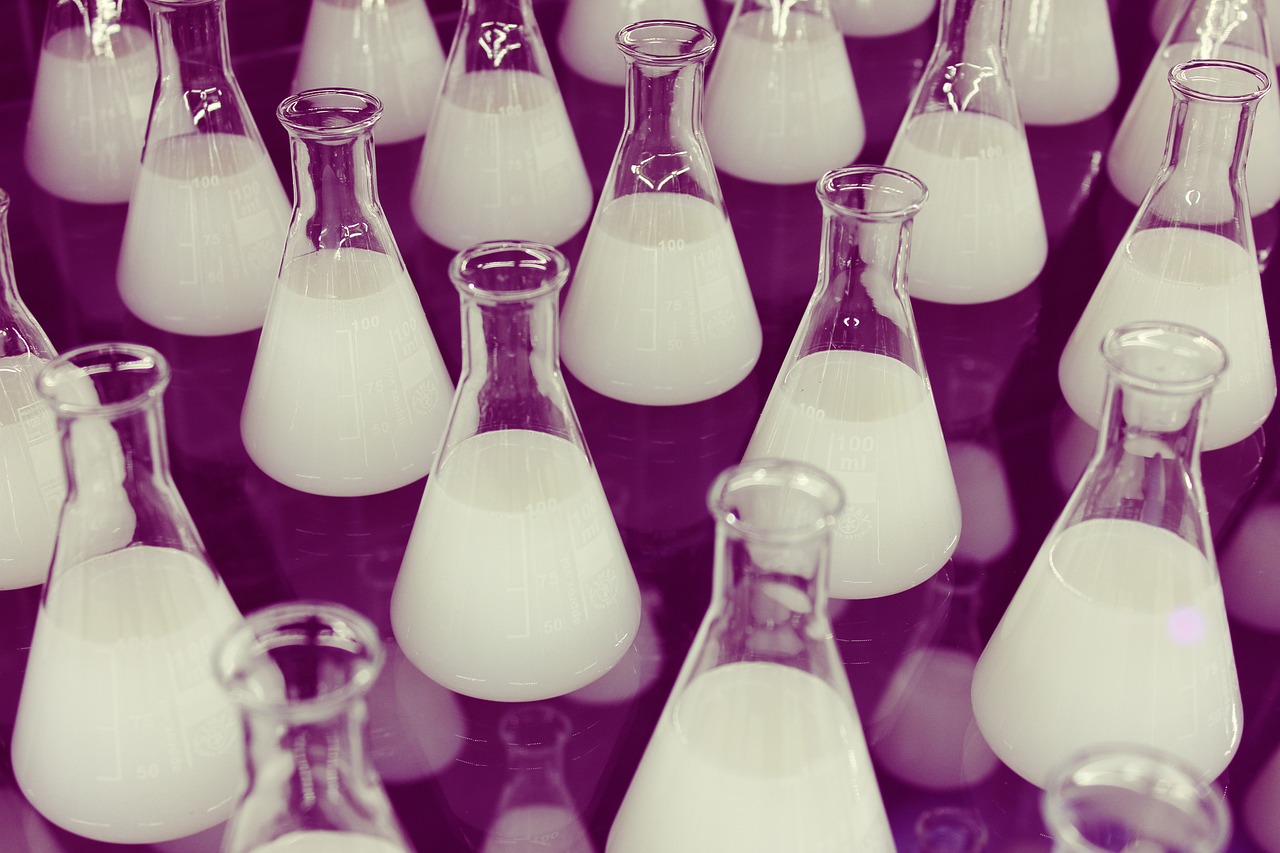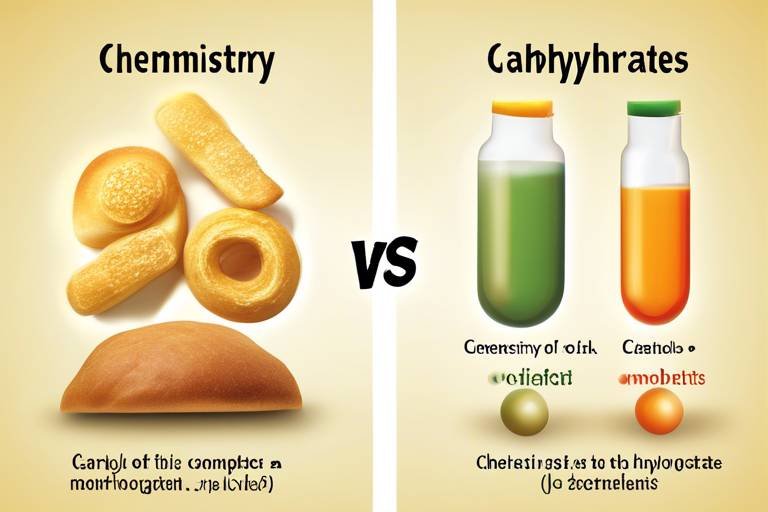The Chemistry of Natural vs. Synthetic Products
This article explores the fundamental differences between natural and synthetic products, focusing on their chemical compositions, benefits, drawbacks, and impacts on health and the environment.
Natural products are derived from living organisms, encompassing a vast array of substances ranging from plants and animals to fungi and microorganisms. These products are often rich in complex chemical structures, which are intricately designed by nature over millions of years. For instance, the therapeutic properties of many herbal medicines can be attributed to specific compounds found within the plants, such as alkaloids and flavonoids. Not only do these compounds contribute to the efficacy of natural products, but they also play crucial ecological roles, such as attracting pollinators or repelling pests. The beauty of natural products lies in their inherent complexity and the way they interact harmoniously with biological systems.
On the flip side, we have synthetic products, which are chemically engineered in laboratories. This fascinating field of synthetic chemistry allows scientists to create substances that may not even exist in nature. Imagine being able to design a molecule from scratch, with specific properties tailored for a particular function! This versatility is one of the most significant advantages of synthetic chemistry. For example, synthetic drugs can be produced with precise dosages and consistent quality, which is often a challenge with natural alternatives. Additionally, synthetic products can be designed to be more stable and have a longer shelf life, making them invaluable in various applications, from pharmaceuticals to everyday household items.
One of the standout features of natural products is their biocompatibility. Many natural substances are less likely to cause adverse side effects compared to their synthetic counterparts. This is particularly evident in the realm of pharmaceuticals, where natural compounds often serve as the basis for drug development. The gentle nature of these products is appealing, especially for individuals seeking alternatives to conventional medicine. Furthermore, natural ingredients in cosmetics and food are increasingly sought after due to consumer demand for cleaner, more transparent product formulations.
When it comes to the environmental impact, natural products typically have a lower footprint. The production of these substances often promotes sustainability and can contribute to the conservation of biodiversity. For instance, using plant-derived ingredients can support local ecosystems and economies. By choosing natural over synthetic, consumers can play a part in preserving the planet, making it a win-win situation. However, it’s essential to recognize that not all natural products are created equal, and their sourcing must be done responsibly to mitigate potential negative impacts.
Despite the numerous benefits of natural products, sourcing them can pose significant challenges. Issues such as overharvesting and habitat destruction are prevalent, particularly as demand for these products increases. As consumers become more aware of these challenges, the importance of sustainable practices in natural product sourcing becomes evident. It is crucial to establish ethical guidelines and support initiatives that promote the responsible use of natural resources. By doing so, we can ensure that these valuable products remain available for future generations.
Synthetic products offer unique advantages that cannot be overlooked. They can be tailored for specific functions, which means they often provide consistent quality and performance. In industries like medicine and manufacturing, this consistency is critical. For example, synthetic polymers are used extensively in medical devices and packaging materials, providing durability and reliability that natural alternatives may not match. The ability to produce large quantities of synthetic substances also means that they can be more cost-effective, making them accessible to a broader audience.
However, while synthetic products have numerous benefits, they can also raise health concerns. The potential risks associated with synthetic chemicals, such as toxicity and long-term effects, are topics of ongoing research and debate. It’s essential to understand that not all synthetic products are harmful, but the importance of regulation cannot be overstated. Stricter guidelines and thorough testing can help mitigate risks and ensure that synthetic products are safe for human use.
When comparing the efficacy of natural versus synthetic products, it's crucial to consider the context of their application. For instance, in medicine, some natural remedies may be effective for mild ailments, while synthetic drugs might be necessary for more severe conditions. In agriculture, natural pesticides can be beneficial for organic farming, but synthetic options may offer more robust solutions for large-scale operations. Ultimately, understanding the strengths and limitations of both categories allows consumers and professionals to make informed choices.
As research advances, the lines between natural and synthetic products continue to blur. Innovations in chemistry are leading to hybrid approaches that combine the best of both worlds. Imagine a future where scientists can create synthetic versions of natural compounds that retain their beneficial properties while eliminating adverse effects. This potential for collaboration between natural and synthetic chemistry opens up exciting possibilities for health, sustainability, and innovation.
- What are natural products? Natural products are substances derived from living organisms, such as plants, animals, and microorganisms.
- What are synthetic products? Synthetic products are chemically engineered substances created in laboratories that may not occur in nature.
- Are natural products always safer than synthetic products? Not necessarily; while natural products often have fewer side effects, they can still pose risks depending on their source and use.
- How can we ensure sustainable sourcing of natural products? Supporting ethical practices and choosing certified sustainable sources can help protect biodiversity and promote responsible use.

Understanding Natural Products
When we talk about natural products, we're diving into a fascinating world filled with substances that come straight from living organisms. These products can range from the spices we sprinkle on our food to the medicines that heal our ailments. The chemical structures of these natural compounds are often complex and intricate, which is a big reason why they possess unique therapeutic properties. For example, consider the way willow bark has been used for centuries as a pain reliever. This ancient remedy contains salicin, which is chemically similar to aspirin, a synthetic drug we know today. Isn’t it amazing how nature has been providing us with solutions long before modern science caught up?
Natural products are not just limited to plants; they also encompass a variety of substances derived from animals and microorganisms. These components play crucial roles in ecological systems and human health. Take, for instance, the antibiotic penicillin, which comes from the mold Penicillium. This discovery revolutionized medicine, showcasing how natural products can lead to life-saving treatments. The beauty of natural products lies in their inherent complexity; their chemical compositions often lead to synergistic effects that can enhance their efficacy. This means that when these compounds work together, they can be more effective than isolated synthetic versions.
However, understanding natural products goes beyond just their chemical makeup. It also involves recognizing their cultural significance. Many indigenous communities have relied on natural remedies for generations, weaving them into their traditions and practices. This connection to nature fosters a sense of respect and responsibility towards the environment. As we explore the benefits of these products, it's essential to consider their ecological roles and the importance of biodiversity.
In today's world, where synthetic alternatives are readily available, it's vital to appreciate the distinct advantages that natural products offer. They are often perceived as safer and more compatible with our bodies, leading to fewer side effects. Additionally, the growing trend towards organic and natural ingredients in various industries, from cosmetics to food, reflects a shift in consumer preferences. People are becoming more conscious about what they put into their bodies and the environment, seeking out products that are not only effective but also sustainable.
As we delve deeper into the realm of natural products, we also need to acknowledge the challenges that come with sourcing them. Issues such as overharvesting and habitat destruction can threaten the very ecosystems that provide these valuable resources. This raises the question: how can we balance our desire for natural products with the need to protect our planet? Sustainable practices become crucial here, ensuring that we can enjoy the benefits of nature without compromising its integrity.

The Role of Synthetic Chemistry
Synthetic chemistry plays a pivotal role in our modern world, acting as a bridge between the realms of nature and innovation. Imagine a world where we could create substances that do not exist in nature, tailored specifically to meet our needs. This is the magic of synthetic chemistry. By manipulating molecular structures in a laboratory, chemists can design compounds with precise characteristics, leading to advancements in numerous fields, from medicine to materials science.
One of the most fascinating aspects of synthetic chemistry is its ability to produce novel compounds. For instance, consider the development of synthetic drugs. Unlike natural products, which can be limited by what nature provides, synthetic chemistry allows for the creation of medications that can target specific biological pathways. This precision means that treatments can be more effective and tailored to individual patients, leading to better health outcomes.
Furthermore, synthetic products are often designed to be stable and consistent. This consistency is crucial in industries like pharmaceuticals, where even the slightest variation in a drug's composition can lead to significant differences in efficacy and safety. By employing synthetic methods, manufacturers can ensure that each batch of a product meets the same high standards, reducing variability and enhancing reliability.
Additionally, synthetic chemistry is not just about creating new drugs; it extends to various applications, including:
- Plastics and Polymers: Synthetic chemistry enables the production of materials that are lightweight, durable, and versatile, revolutionizing industries from packaging to automotive.
- Agricultural Chemicals: The development of synthetic pesticides and fertilizers has transformed farming, allowing for increased crop yields and better pest control.
- Cosmetics: Many cosmetic products rely on synthetic ingredients to achieve desired textures, colors, and shelf stability.
However, it’s important to note that the creation of synthetic products also comes with its own set of challenges. While synthetic chemistry allows for the design of effective and tailored substances, it can also lead to environmental concerns. The production processes may generate waste and pollutants, and the long-term effects of synthetic chemicals on human health and ecosystems are still being studied.
In conclusion, synthetic chemistry is a powerful tool that enables us to innovate and improve our quality of life. As we continue to explore the possibilities of synthetic products, the balance between their benefits and potential risks will be crucial. The future of synthetic chemistry holds exciting prospects, and it will be fascinating to see how it continues to evolve and integrate with natural products in the quest for sustainability and health.

Advantages of Natural Products
When we talk about natural products, we're diving into a world that often feels like a warm hug from Mother Nature herself. These products, derived from living organisms, come with a treasure trove of benefits that many synthetic alternatives simply can't match. One of the most significant advantages is their biocompatibility. This means that our bodies recognize and accept these natural substances more readily, which often results in fewer side effects. For example, when using a natural skincare product, you might find that your skin reacts positively, absorbing the nutrients without the irritation that synthetic chemicals can sometimes cause.
Moreover, natural products are often rich in bioactive compounds that have been fine-tuned by nature over millions of years. These compounds can provide therapeutic benefits that are not only effective but also holistic, addressing multiple health issues simultaneously. Think of it like a symphony where each instrument plays a role in creating beautiful music. In contrast, synthetic products might play a single note but often lack the depth and harmony found in their natural counterparts.
Another compelling aspect is the environmental impact of natural products. They are typically derived from renewable resources, which means their production can promote sustainability. For instance, consider the difference between a natural essential oil and a synthetic fragrance. The former is often extracted from plants through processes that don't harm the environment, while the latter may involve complex chemical processes that can generate waste and pollution. By choosing natural products, consumers can contribute to a greener planet, supporting biodiversity and ecological balance.
However, it's essential to recognize that the advantages of natural products extend beyond just health and environmental factors. They often come with a story, a connection to tradition and culture. When you use a natural remedy or cosmetic, you're not just applying a product; you're engaging with a legacy of knowledge passed down through generations. This connection can foster a greater appreciation for the products we use daily.
In summary, the advantages of natural products are multifaceted, encompassing health benefits, environmental sustainability, and a rich cultural heritage. They offer a holistic approach that resonates with many consumers who are increasingly aware of what they put into their bodies and the world around them. As we continue to explore this realm, it's clear that natural products hold a unique place in our lives, inviting us to embrace their benefits while nurturing our planet.

Environmental Impact of Natural Products
The impact of natural products on the environment is a fascinating topic that intertwines ecology, sustainability, and human health. When we think about natural products, we often imagine pure and untainted substances that come directly from nature. This perception holds a significant amount of truth. Natural products typically have a lower environmental footprint compared to their synthetic counterparts. This is primarily because they are derived from renewable sources and are usually biodegradable, which means they can break down naturally without leaving harmful residues.
For instance, consider the process of extracting essential oils from plants. These oils serve various purposes, from aromatherapy to cosmetics. The extraction process, when done sustainably, can promote biodiversity. By cultivating plants for their natural products, we can encourage the preservation of species and habitats. This is in stark contrast to synthetic chemicals, which often require extensive energy-intensive processes and can contribute to pollution and habitat destruction.
Moreover, many natural products are sourced from agricultural practices that prioritize environmental health. Organic farming, for example, avoids the use of synthetic pesticides and fertilizers, which not only protects the soil and water systems but also supports a diverse ecosystem. This agricultural approach can lead to healthier crops, which in turn can benefit local wildlife and promote a more sustainable food system.
However, it’s crucial to recognize that the sourcing of natural products is not without its challenges. Overharvesting can lead to the depletion of certain species, and habitat destruction can occur when land is cleared for cultivation. This raises an important question: how do we balance the demand for natural products with the need to protect our ecosystems?
To address these challenges, many organizations advocate for sustainable practices in the harvesting of natural resources. This includes implementing certification programs that ensure products are sourced responsibly. For instance, the Forest Stewardship Council (FSC) provides certification for products sourced from responsibly managed forests. Such initiatives can help mitigate the adverse effects of overharvesting and promote long-term ecological balance.
In summary, while natural products generally have a lower environmental impact and can foster biodiversity, it is crucial to adopt sustainable practices in their sourcing. By doing so, we can enjoy the benefits of natural products while ensuring that our planet remains healthy and vibrant for future generations.
- What are natural products? Natural products are substances derived from living organisms, including plants, animals, and microorganisms, that are used for various purposes.
- How do natural products impact the environment? They generally have a lower environmental footprint and can promote biodiversity when sourced sustainably.
- What are the challenges in sourcing natural products? Challenges include overharvesting, habitat destruction, and the need for sustainable practices to protect ecosystems.
- What is sustainable sourcing? Sustainable sourcing involves obtaining natural products in a way that maintains ecological balance and conserves resources for future generations.

Challenges of Sourcing Natural Products
Sourcing natural products is not as straightforward as one might think. While the allure of nature’s bounty is undeniable, there are numerous challenges that come with harvesting these substances. One of the most pressing issues is overharvesting. As demand for natural ingredients in pharmaceuticals, cosmetics, and food continues to rise, many plants and animals face the threat of extinction. Imagine a rare flower, once abundant in the wild, now teetering on the brink of disappearance due to relentless harvesting. This scenario is not just a possibility; it’s a reality for many species.
Another significant challenge is habitat destruction. As we venture deeper into forests and other natural habitats to collect these valuable resources, we inadvertently contribute to the loss of biodiversity. The delicate balance of ecosystems can be disrupted, leading to long-term consequences that affect not only the species we seek but also the entire environment. For instance, the deforestation of rainforests for the extraction of certain plants can result in the loss of countless species that rely on those trees for survival.
Moreover, there are logistical hurdles in sourcing natural products. The remote locations where many of these substances are found can make access difficult. Transporting these materials from far-off places can be costly and time-consuming, leading to increased prices for consumers. Additionally, the quality of natural products can vary significantly based on environmental factors such as climate, soil conditions, and harvesting techniques. This inconsistency can pose challenges for manufacturers who require standardized ingredients for their products.
Finally, the rise of illegal harvesting poses a serious threat to the sustainability of natural resources. In many regions, poaching and unregulated harvesting practices lead to the depletion of vital species. This not only harms the environment but also undermines local economies that depend on sustainable practices. Addressing these issues requires a collective effort from governments, organizations, and consumers alike to promote sustainable sourcing practices and protect our planet's natural treasures.
In conclusion, while natural products offer numerous benefits, the challenges associated with sourcing them are significant. We must be vigilant in our efforts to ensure that our pursuit of these resources does not come at the expense of our environment or the species that inhabit it. Sustainable practices and responsible consumption can pave the way for a future where natural products remain available for generations to come.
- What are natural products?
Natural products are substances derived from living organisms, including plants, animals, and microorganisms, often used for their therapeutic properties.
- Why is overharvesting a concern?
Overharvesting can lead to the extinction of species and disrupt ecosystems, causing long-term environmental damage.
- How does habitat destruction affect natural product sourcing?
Habitat destruction reduces biodiversity and can eliminate the natural environments where these products are sourced, making them harder to find.
- What can consumers do to help?
Consumers can support sustainable practices by choosing products with certifications that ensure responsible sourcing and by reducing their overall consumption of natural resources.

Benefits of Synthetic Products
Synthetic products have revolutionized various industries, offering a plethora of advantages that make them indispensable in today’s world. One of the most significant benefits of synthetic products is their ability to be tailored for specific functions. This means that chemists can design and produce materials with precise properties to meet the demands of various applications. For example, in the pharmaceutical industry, synthetic drugs can be engineered to target specific pathways in the body, enhancing their effectiveness while minimizing side effects. This level of customization is something that natural products often cannot match.
Moreover, synthetic products provide a consistent quality and performance that is crucial for many industries. When you buy a synthetic product, you can expect the same results every time, which is essential for manufacturing processes and consumer goods. This consistency not only boosts efficiency but also helps in maintaining safety standards. For instance, in the food industry, synthetic preservatives can ensure that food remains safe and fresh for longer periods, reducing waste and improving shelf life.
Another notable advantage of synthetic products is their availability and scalability. Natural products can sometimes be scarce or subject to seasonal variations, making them unreliable for mass production. In contrast, synthetic materials can be produced in large quantities, ensuring that they are readily available when needed. This is particularly important in sectors like construction and textiles, where demand can fluctuate dramatically.
Furthermore, synthetic chemistry allows for the creation of substances that may not occur in nature at all. This opens up a world of possibilities, enabling innovations that can lead to breakthroughs in technology and medicine. For instance, synthetic polymers are used in everything from everyday household items to advanced medical devices, showcasing the versatility of synthetic products.
To summarize, the benefits of synthetic products can be encapsulated in the following points:
- Customization: Tailored to meet specific needs.
- Consistency: Reliable quality and performance.
- Scalability: Easily produced in large quantities.
- Innovation: Creation of entirely new substances for various applications.
In conclusion, while natural products have their own set of advantages, the benefits of synthetic products are undeniable. They offer unparalleled customization, consistent quality, and the ability to innovate, making them essential in a wide range of fields. As we continue to advance in chemistry, the role of synthetic products will likely grow even more significant, paving the way for new possibilities and solutions.
1. What are synthetic products made of?
Synthetic products are made through chemical processes that involve combining various elements and compounds to create new substances that may not exist in nature.
2. Are synthetic products safe to use?
While synthetic products can be safe, it’s important to ensure they are properly regulated and tested for safety. Some synthetic chemicals may pose health risks, so it’s essential to follow guidelines and regulations.
3. How do synthetic products compare to natural products in terms of effectiveness?
The effectiveness of synthetic versus natural products can vary depending on the application. In some cases, synthetic products may offer more targeted and effective solutions, while in other cases, natural products may provide broader benefits.
4. Can synthetic products be environmentally friendly?
Yes, many synthetic products are designed to be environmentally friendly, using sustainable practices in their production and disposal. However, it's crucial to assess the lifecycle of these products to understand their overall environmental impact.

Health Concerns with Synthetic Products
When it comes to synthetic products, the conversation often shifts towards their health implications. While these products offer remarkable advantages, such as consistency and tailored functionality, they also bring a set of concerns that cannot be overlooked. One of the primary issues is the potential for toxic reactions in some individuals. Synthetic chemicals, by their very nature, can interact with the human body in ways that natural compounds might not. For instance, certain synthetic additives in food and cosmetics can lead to allergic reactions or sensitivities in a subset of the population.
Moreover, the long-term effects of exposure to many synthetic chemicals remain largely unknown. While regulatory bodies like the FDA and EPA strive to ensure safety, the sheer volume of new substances being introduced into the market can make it challenging to assess their impact fully. For example, substances like phthalates and parabens, commonly found in personal care products, have sparked debates regarding their potential links to hormonal disruptions and other health issues. This uncertainty can lead to public apprehension, prompting many consumers to seek out more natural alternatives.
In addition to individual health impacts, there are also broader concerns related to environmental health. The production and disposal of synthetic products can result in the release of harmful substances into the ecosystem. When these chemicals enter the water supply or soil, they can affect not only human health but also the health of wildlife and plant life. This interconnectedness raises important questions about the sustainability of synthetic chemistry and its long-term viability.
To summarize the health concerns associated with synthetic products, here are some key points:
- Toxic reactions: Some individuals may experience allergic reactions or sensitivities.
- Unknown long-term effects: Many synthetic chemicals lack extensive long-term studies.
- Environmental impact: Production and disposal can harm ecosystems.
In conclusion, while synthetic products play a vital role in modern society, it is crucial to remain vigilant about their health implications. Consumers should be informed and cautious, advocating for transparency in ingredient labeling and supporting regulations that prioritize safety. As we continue to navigate the complex landscape of synthetic chemistry, understanding these health concerns will empower us to make better choices for ourselves and the planet.
- What are synthetic products? Synthetic products are man-made substances created through chemical processes, often designed to mimic natural compounds or serve specific functions.
- Are synthetic products safe to use? While many synthetic products are deemed safe by regulatory bodies, some may pose health risks. It's essential to read labels and be aware of potential allergens or harmful ingredients.
- How do synthetic products affect the environment? The production and disposal of synthetic products can lead to pollution and harm ecosystems, raising concerns about sustainability.
- What are the benefits of natural products? Natural products often have fewer side effects, are more biocompatible, and typically have a lower environmental impact compared to their synthetic counterparts.

Comparative Analysis of Efficacy
When it comes to the efficacy of natural versus synthetic products, the debate is as vibrant as a painter's palette. Each category has its own strengths and weaknesses, often making the choice between them a complex decision influenced by various factors, including application, cost, and availability. For instance, in the realm of medicine, natural products such as herbal remedies have been used for centuries, offering a plethora of health benefits. However, their efficacy can sometimes be inconsistent due to variations in plant quality and preparation methods. On the other hand, synthetic products, engineered with precision in laboratories, often provide consistent results that can be replicated across different batches.
To illustrate the differences in efficacy, let’s consider a few examples:
| Product Type | Example | Efficacy |
|---|---|---|
| Natural | Willow Bark (Salicylic Acid) | Effective for pain relief but varies by source and preparation. |
| Synthetic | Aspirin (Acetylsalicylic Acid) | Highly effective with consistent dosage and predictable results. |
In agriculture, the efficacy of natural pesticides versus synthetic ones presents another interesting comparison. Natural pesticides often rely on naturally occurring substances, which can be less harmful to the environment and non-target species. However, their effectiveness can vary significantly depending on environmental conditions and pest resistance. Conversely, synthetic pesticides can be engineered to target specific pests, providing a high level of control. Yet, they may pose risks to non-target organisms and contribute to environmental degradation if not used responsibly.
Moreover, the economic aspect of efficacy cannot be overlooked. Synthetic products, while often more expensive upfront, can lead to cost savings in the long term due to their effectiveness and efficiency in application. Natural products, although generally cheaper, may require more frequent application and can lead to higher overall costs. This creates a balancing act for consumers and industries alike, weighing the benefits of sustainability against the need for reliable performance.
Ultimately, the comparative analysis of efficacy between natural and synthetic products is not just a matter of choosing one over the other. Instead, it calls for a nuanced understanding of the context in which these products are used. As research continues to evolve, the potential for hybrid approaches—combining the best of both worlds—grows ever more promising. This could lead to innovations that harness the therapeutic properties of natural products while ensuring the reliability and consistency of synthetic alternatives.
- What are the main differences between natural and synthetic products? Natural products are derived from living organisms, while synthetic products are chemically engineered in laboratories.
- Are natural products always safer than synthetic ones? Not necessarily. While natural products often have fewer side effects, they can still pose risks, and synthetic products can be safe when properly regulated.
- How can I choose between natural and synthetic products? Consider the specific application, efficacy, safety, and environmental impact of the products in question.

The Future of Natural and Synthetic Chemistry
The landscape of chemistry is evolving at an astonishing pace, and the future of natural and synthetic products is brimming with potential. As we stand at the crossroads of innovation, the lines between what is considered "natural" and "synthetic" are becoming increasingly blurred. This transformation is not merely a trend; it is a fundamental shift in how we perceive and utilize chemical substances in our daily lives.
One of the most exciting aspects of this evolution is the rise of hybrid products. These are substances that combine the best attributes of both natural and synthetic components. Imagine a skincare product that harnesses the nourishing properties of natural oils while incorporating synthetic compounds that enhance stability and shelf life. This synergy could lead to products that are not only effective but also environmentally friendly. As consumers become more aware of the ingredients in their products, the demand for such innovations is likely to soar.
Moreover, advancements in technology are paving the way for more sustainable practices in both natural and synthetic chemistry. For instance, researchers are exploring biotechnology and green chemistry to develop processes that minimize waste and reduce the environmental impact of chemical production. This includes using renewable resources and designing chemical processes that are less harmful to ecosystems. The goal is to create a future where chemistry contributes positively to the planet rather than detracting from it.
In addition, the integration of artificial intelligence (AI) and machine learning in chemical research is revolutionizing the way we develop new products. AI can analyze vast amounts of data to predict how different compounds will interact, significantly speeding up the discovery of new materials. This means that scientists can create more targeted and effective natural and synthetic products, tailored to specific needs and preferences.
However, this bright future is not without its challenges. The rapid pace of innovation raises questions about regulation and safety. As new compounds are developed, ensuring they are safe for human use and the environment becomes paramount. Regulatory bodies will need to adapt to keep up with these advancements, striking a balance between fostering innovation and protecting public health.
In conclusion, the future of natural and synthetic chemistry is a tapestry woven from innovation, sustainability, and safety. As we embrace this new era, it is crucial to remain vigilant about the implications of our choices. By fostering collaboration between natural and synthetic approaches, we can unlock a world of possibilities that not only meets our needs but also respects the delicate balance of our environment.
- What are hybrid products? Hybrid products integrate both natural and synthetic components to enhance effectiveness and sustainability.
- How is AI influencing chemistry? AI is helping researchers analyze data more efficiently, leading to faster development of new materials and products.
- What are the environmental benefits of green chemistry? Green chemistry focuses on reducing waste and using renewable resources, which can significantly lower the environmental impact of chemical production.
- Are synthetic products safe? While synthetic products can offer many benefits, their safety depends on rigorous testing and regulation to ensure they do not pose health risks.
Frequently Asked Questions
- What are the main differences between natural and synthetic products?
Natural products are derived from living organisms, while synthetic products are chemically engineered in laboratories. This fundamental difference affects their chemical compositions, benefits, and environmental impacts.
- Are natural products always safer than synthetic ones?
While natural products often have fewer side effects and greater biocompatibility, it's not a guarantee that they are always safer. Some natural substances can be toxic, and synthetic products are rigorously tested for safety.
- How do natural products impact the environment?
Natural products typically have a lower environmental footprint, promoting sustainability and biodiversity. However, sourcing them can lead to challenges like overharvesting and habitat destruction if not managed responsibly.
- What are the advantages of synthetic products?
Synthetic products can be tailored for specific functions, ensuring consistent quality and performance. They allow for the creation of substances that may not occur in nature, making them invaluable in various industries.
- Can synthetic products pose health risks?
Yes, synthetic products can raise health concerns, including potential toxicity and long-term effects. It's crucial for these products to be regulated and tested to mitigate any risks associated with their use.
- How do natural and synthetic products compare in terms of efficacy?
The efficacy of natural versus synthetic products varies depending on the application. In some cases, natural products may offer superior benefits, while in others, synthetic options might be more effective due to their tailored nature.
- What does the future hold for natural and synthetic chemistry?
The future is likely to see a blending of natural and synthetic approaches, with research focusing on hybrid solutions that harness the best of both worlds. Innovations in chemistry may lead to more sustainable and effective products.



















